 |
 |
 |
Our route:
01.11.02:
Sapanta
02.11.02:
Maramuresh
Barsana
Bogdan Voda
03.11.02:
Vatra Dornei
04.11.02:
Moldavie
Moldovita
Sucevita
Radauti
Abore
05.11.02:
Bacau
06.11.02 - 07.11.02:
Brasov
08.11.02:
Fagaras
Carta
09.11.02:
Sibiu
10.11.02:
Axente Sever
Copsa Mica
Valea Viilor
Medias
11.11.02:
Biertan
Sighisoara
12.11.02:
Rupea
Feldioara
Rasnov
13.11.02:
Bran
Poiana Brasov
Brasov
14.11.02 - 04.12.02:
Sfantu Gheorghe
16.11.02 - 17.11.02:
Bucuresti
05.12.02:
Sinaia/Peles
Our route - II:
02.06.04:
Bucuresti
03.06.04 -14.06.04:
Carta
Brasov
Sibiu
Sighisoara
|
|
 |
| Romania |
 |
 |
 |
 |
 |
 |
On this page, we (will) describe our experiences in Romania.
Apart from the travelogue for this country
you will also find a number of links to useful sites,
ranging from general information to embassy homepages.
Written by: Coen
The first part of the road after passing the Hungarian border was OK, this changed after the first few kilometers. When we arrived in Oradea and waited for the traffic lights, we were attacked by gypsy boys, cleaning our window and climbing on our car. Sorry boys, the money is in the fuel tank. When we went to the bank to get some Romanian cash, the gypsies were waiting in rows.
After we left Oradea we drove north. It started to get dark and we could not find a hotel to park let alone a camping site. We drove through the dirty and poor villages with poor people and a lot of rubbish. More horse carriages than cars and pieces of extremely bad road. Eventually we parked in a muddy village next to a small pub with trucks passing by the whole night. This was our first experience with Romania, fortunately not the only one.
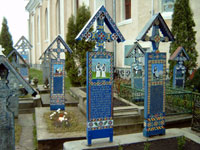 The next day was again full of impressions. In the village everybody stared at me when I went to buy some bread. It was full of stray dogs and ox carriages. Because of the rain, the unpaved roads (in the villages only the main road is paved) turned into mud baths. After the first day in Romania, our car was covered with mud.
We drove in direction Maramuresh, an area in the north of Romania at the Ukrainian border. We saw dangerous overtaking maneuvers by overloaded trucks and everywhere we saw ran over dead dogs and carriages with traveling gypsies. The police looked dangerous and we were advised to stay away from them.
The next day was again full of impressions. In the village everybody stared at me when I went to buy some bread. It was full of stray dogs and ox carriages. Because of the rain, the unpaved roads (in the villages only the main road is paved) turned into mud baths. After the first day in Romania, our car was covered with mud.
We drove in direction Maramuresh, an area in the north of Romania at the Ukrainian border. We saw dangerous overtaking maneuvers by overloaded trucks and everywhere we saw ran over dead dogs and carriages with traveling gypsies. The police looked dangerous and we were advised to stay away from them.
Satu Mare was our next destination but there wasn't much to see.
It was raining and the car was full of mud and shit.
After we went over the Huta-pass, we drove to the friendly village Sapanta. Here we went to visit the happy cemetery; a graveyard with beautifully colored wood carved graves, representing the good and bad habits of the dead.
We drove in direction Sigheta Marmatieu, through the magnificent Maramuresh area, where the farms in the little farmer villages have beautifully wood carved entrance gates. On the road we passed goose tenants, sheep tenants and ox carriages. Remarkable are the traditional clothes almost everybody is wearing here. The people sometimes live in very poor conditions but they all wave at us and are extremely hospitable.
 Over muddy roads we drove to Birsana. Here we visited a fantastic old wooden monastery with several buildings. The nuns maintained the place very well. From here we drove to Leud. In Leud we followed a muddy road deeper into the village. The last 2 kilometers we walked towards an old middle-age wooden church. We walked along the primitives farms and along the courtyards where people have lived the same life for over 200 years. We felt like being in an open air museum. We were rewarded with an old wooden church from 1364! on top of a hill. A farmer girl came out of farm to take a closer look at Dorrit.
Over muddy roads we drove to Birsana. Here we visited a fantastic old wooden monastery with several buildings. The nuns maintained the place very well. From here we drove to Leud. In Leud we followed a muddy road deeper into the village. The last 2 kilometers we walked towards an old middle-age wooden church. We walked along the primitives farms and along the courtyards where people have lived the same life for over 200 years. We felt like being in an open air museum. We were rewarded with an old wooden church from 1364! on top of a hill. A farmer girl came out of farm to take a closer look at Dorrit.
We spent the night with a family who rented a room for tourists. We could park in the garden and the woman spoke French. We exchanged stories and the next morning we had coffee together. Dorrit was being put in traditional clothes and I made pictures of course.
After the coffee we drove through the little farmer villages in direction North-Moldavia (the first screws already came out of the dashboard). Because it was Sunday, the inhabitants of the villages all wore traditional clothing. Each village had its own clothing. It was great to see the different colors of the skirts, the furs and the head covers.
Unfortunately the Romanians are not very environmental-friendly. The lovely twisting rivers were full of garbage. Even old cars and fridges lie half in the water.
After we went over the 25 kilometers long serpentine Prislop-pass, we arrived in North-Moldavia. The surroundings and the villages changed completely. The villages were full of wooden carved and mosaic colored houses. The road moved through a national park with sheer cliffs and pine forest. In Vatra Dornei, a small thermal village situated in a valley, we spent the night.
 It was -5° when we woke up. Heating on and directly to Vatra Moldavita. Here we visited one of the 6 famous 15th century Moldavian Monasteries. Wonderful colored wall paintings which originally represented the bible stories for the people who had to stay outside the church.
It was -5° when we woke up. Heating on and directly to Vatra Moldavita. Here we visited one of the 6 famous 15th century Moldavian Monasteries. Wonderful colored wall paintings which originally represented the bible stories for the people who had to stay outside the church.
After this visit we had to drive over the highest pass of Romania. In Romania the mountains lay as a loop in the country, that's why we had to cover so many passes. This one turned out to be a drama because in the meanwhile it started to snow. A truck, almost at the top, started to slip and could not move anymore...
When we arrived at the other side of the pass, we visited the second monastery - Sucevita. Again most magnificent fresco's and painted interiors. On our way to the Arbore monastry, it started to snow heavily. We were too late finding a place to spent the night, so we ended up driving through the snow in the darkness. Finally we parked in front of a police station.
When we woke up in the morning another 25 cm of snow had been fallen. Because the other monasteries were not reachable because of the snow and because we had the be in Transylvania the 14th of November, we decided to review our route.
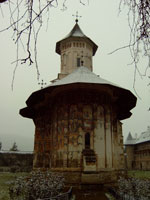 We had to dig out the car out of the snow before we could drive to Suceava. The landscape was marvelous. Unfortunately the thorough road wasn't cleaned so we drove, as one of the few cars, on a 5 cm thick ice layer. All around us the trucks slipped off the road or got stuck in the snow. Happily we could move slowly...
We had to dig out the car out of the snow before we could drive to Suceava. The landscape was marvelous. Unfortunately the thorough road wasn't cleaned so we drove, as one of the few cars, on a 5 cm thick ice layer. All around us the trucks slipped off the road or got stuck in the snow. Happily we could move slowly...
When I wanted to get diesel (my nerves were already blank because of the traffic), I saw the friendly Romanian filling the diesel tank with a green "lead-free petrol" hose. Thank god those were second-hand green German hoses and it was diesel coming out after all.
That night it was freezing. A pity for the people on the ox-carriages; with every passing truck they got a splash of brown snow all over them. We went over the last pass to Brasov. It was a beautiful winter scenery. On the other side of the mountains, the snow was gone! Hurray, we are in Transylvania.
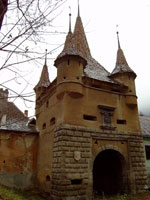 On camping Brasov we could have a shower in a bungalow (Not sure that we got any cleaner...) so we took the bunch of stray dogs and the begging gypsies for granted. This was our starting point to visit Brasov.
On camping Brasov we could have a shower in a bungalow (Not sure that we got any cleaner...) so we took the bunch of stray dogs and the begging gypsies for granted. This was our starting point to visit Brasov.
After a deadly taxi tour in Bebe's taxi we arrived in Brasov. Brasov is a beautiful middle-age German town, nicely restaurated.
At night in a restaurant we were lucky that there was a wedding the next day. The waiter organized with the kitchen that we could eat the traditional Romanian wedding dish, Sarmalla, meat-rolls in sour coal-leaves with spicy sausages and corn porridge.
The following days we explored Transylvania. On our way to Sibiu we passed a sign with: "camping de oude wilg" (Dutch) so we had the check that out. In a typical small Romanian village we indeed found the camping site that belonged to Tudor and Manette. Tudor is a Romanian and Manette comes from Scheveningen in Holland. We were received very friendly and it was nice to talk with some Dutch people again. We were invited for dinner (Romanian Mititei) and we chatted all night. It was great. Their camping site is very cosy and decorated artistically. You feel at home immediately. Tip!
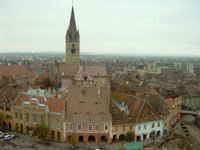 After saying goodbye to Tudor and Manette we drove to Sibiu. The originally German town (Hermannstadt) is a wonderful medieval town with 3 almost intact defense walls, the oldest dates from the 12th century. We walked through the medieval narrow streets and climbed the old stairs. We really felt like being in the middle ages. On the street we met Dan, a French-speaking Romanian. We had a coffee together and were invited at his place. We chatted and had muscadet wine from a plastic bottle.
After saying goodbye to Tudor and Manette we drove to Sibiu. The originally German town (Hermannstadt) is a wonderful medieval town with 3 almost intact defense walls, the oldest dates from the 12th century. We walked through the medieval narrow streets and climbed the old stairs. We really felt like being in the middle ages. On the street we met Dan, a French-speaking Romanian. We had a coffee together and were invited at his place. We chatted and had muscadet wine from a plastic bottle.
When we were in the car again the next day, we passed in Axente Sever (Frauendorf) an ancient medieval German armed church. A toothless Hungarian served us with an hour long guided tour. The church was from 1322 and completely original, really magnificent.
The next remarkable village was Copsa Mica. Here is a factory that produced soot and sulphur. This is the most toxicated village in Europe. Soot is not being produced anymore, but a part of the village is still black. The inhabitants reach an average age of only 40. And how the place stank!
In Valea Viilor (Wurmloch) Herr Schneider showed us around in another armed church. He is one of the last 19 remaining Romanian-Germans (Siebenbuerger Sachsen) in that village. All the young people left for Germany. "The last one of us lays down the key" as Herr Schneider described.
We continued our tour to Medias, another medieval little town. We walked around and visited the monastery.
Next day we visited the biggest armed church with three nice towers and a beautiful court yard in Biertan. From here we drove through the beautiful and sloping landscape. All around us drove the horse carriages and the people where staring at us. Dorrit feeds the stray dogs with the left over bread every day.
In a little village we drove through was a riot. 40 farmers with shovels and sticks were blocking the road in front of the town hall. No problem…
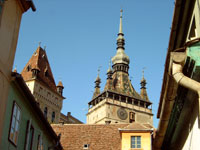 We arrived in Sighisoara early, another splendid medieval town, also called the Neurenberg of Transylvania. It is a beautiful fortified city where 9 of the 14 and a big part of the medieval city is preserved. Again we could spend the night without having to pay a penny at a parking place of a pension.
We arrived in Sighisoara early, another splendid medieval town, also called the Neurenberg of Transylvania. It is a beautiful fortified city where 9 of the 14 and a big part of the medieval city is preserved. Again we could spend the night without having to pay a penny at a parking place of a pension.
The next day we drove to Rasnov via the farmer castle in Rupea and via the Marienburg in Feldioara. In Rasnov is a huge restaurated farmer castle with a nice museum.
After breakfast the next day we drove to Bran to visit the Dracula castle. I just finished the book by Bram Stoker so I could imagine that the castle is used as an example for his Dracula story (although Bram Stoker never visited the castle). Little rooms and corridors everywhere. At the Dracula market we bought some post-cards and the stray dogs followed us to our car.
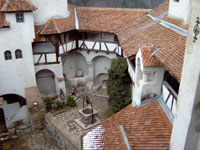 From Bran we took the back road to Poiana Brasov, a new and modern Romanian winter sport town. We walked uphill and had a "real" cappuccino.
Transylvania is a fantastic part of Romania. It is much richer than the rest and a lot of Romanian-Hungarians live here.
From Bran we took the back road to Poiana Brasov, a new and modern Romanian winter sport town. We walked uphill and had a "real" cappuccino.
Transylvania is a fantastic part of Romania. It is much richer than the rest and a lot of Romanian-Hungarians live here.
The next day we drove to Sfintu Gheorghe where we are going to work at another Global Teenager Project during the coming three weeks.
Kinga, the local coordinator of the GTP in Romania received us very friendly. We could park our car in their back yard and we had to share this garden with a huge terrier called Alex. For Alex our camper turned out to be the love of his life. He only wanted to lie under the car.
We were introduced to our colleagues for the coming 3 weeks; Reka and Szabi.
Kinga's mother in law offered us to join them for dinner the coming weeks so we were able to enjoy the ins and outs of the Hungarian and Romanian kitchen every day.
These 3 weeks were fantastic. Apart from the IT-, Project management and Teambuilding courses we organized, we did several nice things. For a report on the trainings, click here.
 The first weekend we took the train to Bucharest. On the train we met Leslie and Dustin, 2 Americans who also worked in Sf. Gheorghe as teachers.
The first weekend we took the train to Bucharest. On the train we met Leslie and Dustin, 2 Americans who also worked in Sf. Gheorghe as teachers.
In Bucharest we stayed at a hotel with a huge rubbish dump with stray dogs at the back of the hotel (which we only saw after we had paid...).
The weather was sunny during our stay. From the revolution place (with bullet holes everywhere) we walked to the center. The city has a French atmosphere. It is also called the Paris of the east. In several buildings you find eastern influences.
Impressive of course was the giant Ceausescu palace with halls as big as caves and inside made out of pink marble and gold. From the balcony you have a view over the enormous, never-ending lane, the Boulevard Unirii. Incredibly big (after the Pentagon the biggest building in the world). At night we had a drink at the "Hanul", a authentic tavern were the medieval caravans from the far east spent the night.
The next morning we visited the national museum and looked at a cast of the Traianus pillar (original in Rome) and we saw the treasures in the cellar. At night we took the train back to Sf. Gheorge. It started to get cold. That night it froze 8 degrees.
 A lot of our spare time during the trainings in Sf. Gheorghe, we have spent with Szabi and his girlfriend Rebeka. Everytime Szabi found other Hungarians who joined us with a guitar and something to drink. I had some good practice and every time we had a great time. With Szabi and Rebeka we also discovered the places of entertainment in Sf. Gheorghe. We also met up with Leslie (the American girl).
A lot of our spare time during the trainings in Sf. Gheorghe, we have spent with Szabi and his girlfriend Rebeka. Everytime Szabi found other Hungarians who joined us with a guitar and something to drink. I had some good practice and every time we had a great time. With Szabi and Rebeka we also discovered the places of entertainment in Sf. Gheorghe. We also met up with Leslie (the American girl).
Further we had dinner with Szabi's parents, I baked pancakes for everybody and we went to a vulcanic lake.
The last night we said goodbye to everybody and they had bought us a CD with Romanian-Hungarian music and a bottle of Hubertus. Very nice!
We had to leave Romania because according to the weather forecast it was going to freeze 15 degrees which is too much to live in a car. It is a pity because there is so much to see in Romania.
In the beginning we had some difficulties getting used to Romania but it turned out to be a great country. Here the people are really hospitable, it is not full of tourists and if you do not expect a perfect tourist infrastructure, it is a nice and safe holiday country.
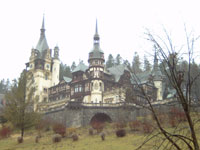 Our last day in Romania we visited the Peles castle, a beautiful castle in the middle of a forest. That day we drove to until 80 km above Bucharest. The next day we woke up at six o'clock to drive as far as possible. We did not want to drive through Bucharest so we though to be clever and take the ring around Bucharest. This one-lane road consisted mainly of holes, bumps and mud. Whole pieces of concrete were missing and some parts were so full of water that we could drive only at walk.
Our last day in Romania we visited the Peles castle, a beautiful castle in the middle of a forest. That day we drove to until 80 km above Bucharest. The next day we woke up at six o'clock to drive as far as possible. We did not want to drive through Bucharest so we though to be clever and take the ring around Bucharest. This one-lane road consisted mainly of holes, bumps and mud. Whole pieces of concrete were missing and some parts were so full of water that we could drive only at walk.
Everywhere around us rubbish and slums. Tip from us: never take the ring around Bucharest!
We want to drive to Greece at once..hmmm, if that is going to work out? Dorrit will write more about in the Bulgaria diary.
Coen
|
 |
|
 |
 |
 |
 |
Our top 5: |
 |
 |
1. Sighisoara
2. Sibiu
3. Brasov
4. Moldavia
5. Maramuresh
|
 |
 |
 |
 |
 |
 |
 |
 |
TIP! |
 |
 |
The best camping in Romania:
Camping "De oude wilg"
Prudului 311
2409 Carta
Judetul Sibiu
Tel: +40 (0)721 86 343
de_oude_wilg@yahoo.com
|
 |
 |
 |
 |
 |
 |
 |
 |
TIP |
 |
 |
A good pension in Sighisoara:
Str. Mihai Eminescu 62
3050 Sighisoara
Judetul Mures
Tel: +40 (0)65 77 88 50
|
 |
 |
 |
 |
 |
 |
 |
 |
TIP |
 |
 |
A good pension in Maramuresh:
Busta Anuta
Loc. Bogdan Voda 27
Maramures
Tel: 04/0262/335082
|
 |
 |
 |
 |
 |
 |
 |
|


